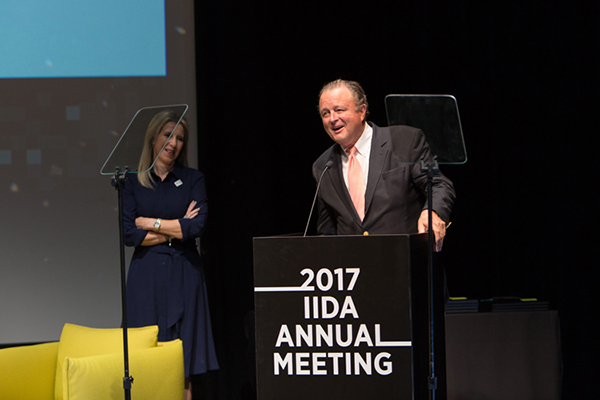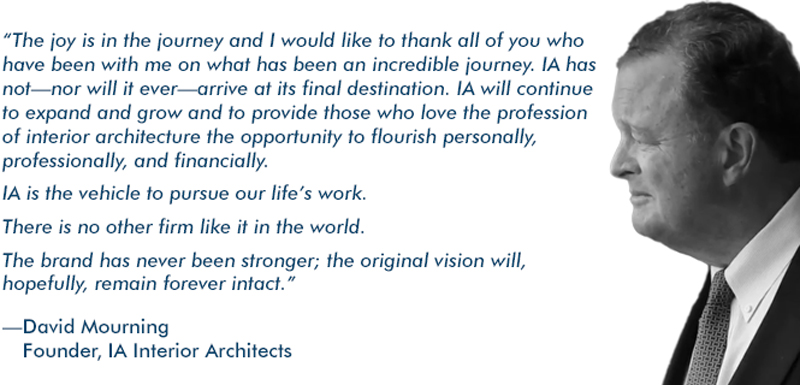David Mourning, AIA, FIIDA, Entrepreneur and Founder of IA Interior Architects

These days there is a lot of talk about entrepreneurialism. As jobs in traditional employment sectors keep disappearing, we Americans rely more and more on entrepreneurs to create the new kinds of jobs that will keep us gainfully employed in the future. In 1984 when David Mourning founded IA Interior Architects there were virtually no architectural firms dedicated to only designing interiors, but that was the vision for the new company when he and two colleagues left Environmental Planning and Research (EPR) in Los Angeles to establish IA.

Mr. Mourning wrote, “EPR was a great company and I can thank it for many things, but first and foremost, I learned to love the practice of interior design at EPR. I found it in many ways more creative, exciting, fast paced, and professionally rewarding than conventional base building design. I also recognized the practice of interiors to be more resistant to the economic cycles that cause revenue swings in most architectural firms. It was something with huge potential and I loved it. It was time to move on and establish IA.”
In many ways the story of IA reflects a new “American Dream.” If it’s up to entrepreneurs to create the new economy, IA can be held up as a shining, successful example. Entrepreneurialism isn’t always about inventing a new widget or technology; it’s often about recognizing and taking advantage of a shift in attitudes. To some extent that’s been a large factor in the success for IA.
On a recent Saturday afternoon while enjoying the sun and too much food at an outdoor table Mr. Mourning told me this story, “When I was in high school I was a pretty good basketball player. But when I saw players with real talent I realized that basketball, as much as I loved it, wasn’t my future (I once tried to play defense against future UCLA and NBA great, Lucius Allen.) As a young architect I thought I was pretty good, but very early on when I met someone that just had that gift, that talent, I realized that my future in architecture was on the management side, the business side.”
“I have always had the greatest respect for people who have that creative spark – who can create things other people can’t – see things other people can’t see, and I’ve done my best to attract those kinds of people to IA.”
“Another thing I thought about while at EPR that led me to envision IA as an interiors only practice was that in most architectural firms the interiors staff feel like 2nd class citizens. I thought if I could build a firm where interior design was the only business, I’d be able to attract the most talented and entrepreneurial interior designers. That proved to be the case from the get-go and was a large factor in our tremendous growth. The other factor was women. To this day women in architecture have not achieved the level of success and acclaim they should have. But at IA we have been fortunate to have unbelievably talented and impressive women join our ranks and our leadership team. Talented men and women who loved the practice of interior design and didn’t want to be treated like 2nd class citizens in an architecture firm have been the key to our success.”

And how do you measure that success? One way is to simply recite a couple of the stats. From its start in 1984 IA has grown to 19 offices in the U.S., Canada, and the U.K. and staff of approximately 600. It has a network of “global Alliance Partners” in 52 cities around the globe. And perhaps most impressive, IA is going on 33 years in business and still finds many of its original clients in its customer list.
On a recent trip to New York I was “at table” with Julio Braga, Co-Managing Director of the New York IA office. As he regaled me with a few great David Mourning stories, it came to my attention that Mr. Mourning was to receive yet another honor, the awarding of the 2017 IIDA Star Award at the association’s Annual Meeting the Sunday before NeoCon. To quote from IIDA’s announcement concerning the Star Award, “This prestigious award is given to an individual or organization that has made significant contributions to the design industry.”

While he has certainly not sought it, throughout his career he has received accolades and recognition of his stature in the eyes of his peers, In 2015 Contract magazine awarded Mr. Mourning its “Legend Award.” He is registered to practice architecture in 27 states, a member of the American Institute of Architects (AIA), carries NCARB certification, has been awarded FIIDA status and has served as a commissioner on the California State Board of Architectural Examiners.
While his style is self-effacing, his bearing and carriage are energetic, confident and witty. When we met in the lobby of my hotel that Saturday before NeoCon, he was wearing shorts and a Hawaiian shirt. I immediately noticed that his whole left leg was bandaged from ankle to mid-thigh. As we started to walk rather briskly, I asked what was going on and he answered, “I had knee replacement surgery Tuesday.” When I asked how on earth he was able to walk around only 4 days later, he characteristically gave all the credit to his doctor – “Oh, my doctor is just fantastic!”

looking on. She is Managing Director of IA-Miami, and the outgoing
IIDA International President. She became an IIDA Fellow at the 2017
Annual Meeting. Photo courtesy of IIDA
In fact, David Mourning is the kind of leader who is most comfortable giving credit to others. And perhaps that is the key to his success. People who know him, but have never worked for him wish they had. People who have worked for him can hardly contain their enthusiasm when telling great and often humorous stories about experiences they’ve had along the way. And that’s how this article came about.
So entrepreneurs abound. And they do generate new jobs; the problem is that most of them fail. The real test of an entrepreneur is whether the entity they start grows to a significant extent and continues after the founder exits. As the largest interiors-only design firm with 19 offices and ~600 people IA has achieved the growth milestone. As for how the company endures after the founder exits, only time will tell. But Mr. Mourning started on his succession plan early. In 2014 he put his shares of the company in an ESOP (Employee Stock Ownership Plan) and IA became an employee owned firm.
Since then he has been engaged in the full transfer of not only ownership but also the leadership of the firm. In synch with the company’s entrepreneurial spirit and collaborative approach, overall leadership of the firm has been given to Co-President and CEOs, Tom Powers and David Bourke and leadership at several of the largest offices is shared by Co-Managing Directors. Eleven of the offices are led by women!

These days, Mr. Mourning tells me, he shows up at the office a couple of times a week, but the firm is thriving under its new leadership and he’s completely satisfied that it will continue to do so. I believe him.












